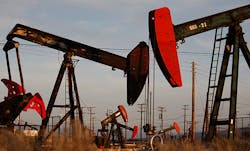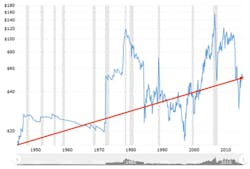Oil Prices, Predictions And the Problem With Predictions: Progress in EHS
A lot of time and money is spent on trying to predict the future. There are organizations built around it, millions of dollars spent on it and alas – as those in the UK and United States experienced first-hand in the political landscape of 2016 – they don’t always get it right (if I’m going there, I might as well say they got it downright wrong.)
Companies will pay big bucks for advisors to do what they do best and advise on what to expect in coming years. If Blockbuster knew that one day internet streaming of films would become as big as it has, I’m pretty sure they’d have moved much faster.
Staying ahead of the game is one of the cornerstones of successful capitalist participants, and one of the biggest players in the capitalist world is the oil industry: the Organization of the Petroleum Exporting Countries (OPEC) – nations such as Saudi Arabia, Iran, Algeria and Qatar – earned over $982 billion in net oil exports in 2013 alone. That figure doesn’t even include revenues from the United States, Europe or Far East Asia.
Peak Predictions, Price Continue to Fluctuate
Year-on-year, there are predictions of when the world will run out of oil. It’s certainly a worry on a planet that massively depends on it for transport, machinery, heating, lighting and more. (Check out this timeline of "oil peak" dates that have been called in the past and that have come and gone without apocalypse).
Now, governments and oil and gas companies are funding research into sustainable alternatives as we continue down the path of preparation for the day the oil runs out. Interestingly, what we’ve seen in recent years is so much supply from OPEC – in a bid to defend their market share against the United States – that the price of oil fell from $113 per barrel in 2013 to just $32 per barrel in 2016. This came as the industry was still recovering from the significant drop in 2008; the shock of which was heightened by experts’ claims just months before that oil was about to reach $200 per barrel. They were only around $150/barrel off the mark.
Not surprisingly, this has had major ramifications for oil and gas companies throughout the world. Globally, over 350,000 workers have lost their jobs since the dip in 2014. Prices are picking up three years later, but only after OPEC and Russia agreed to curb production rates as the negative effects of cheap oil reached the economies of member countries. The industry is recovering, but a barrel of oil will still only set you back $50. We might, in fact, be defying all oil-Armageddon prognoses to date, and instead be experiencing peak demand long before peak supply. Whoever would have thunk it?
Profits and the Path to Redemption
Combine subdued production with the oil-and-gas-friendly rhetoric from the Trump administration, and it’s plausible that the industry could be on the path to redemption. President Donald Trump has already, although controversially, signed executive orders on advancing the Keystone XL and Dakota Access pipelines, and the United States looks set to be a net exporter of oil by 2050 (again with those predictions!).
As regulations are cut by the Trump administration, profits will likely start to climb. So, does more profit potentially mean more investment in EHS, right? Well, not without the worry that the very change that leads to increased profits also wipes out the need for EHS spending: deregulation. The Environmental Protection Agency (EPA) already is anticipating taking a massive hit to its funding.
Are executives committed to EHS morally, and not just because compliance with existing regulations is mandated? Do you dare predict what will happen?
What Is the Role of EHS?
With the oil industry rebounding, the hope is that the upturn will have a positive effect on EHS. Actually, despite thousands of job losses and cost-cutting, the oil and gas industry remains the biggest spender on EHS and sustainability software, accounting for $342 million-worth of fees in 2016, or 37 percent of the entire global market, according to Verdantix. This may come as a surprise when other studies reveal that only 10 percent of oil and gas companies expect to increase EHS budgets in 2017, while 19 percent of DNV GL survey respondents say cost-cutting in the industry is raising health and safety risk at their organizations.
Unfortunately, the man who predicted the 2014 crash is predicting another later in 2017. Whether this is “future babble” or not, expectations of downturns in the oil and gas industry will have one of two outcomes for EHS: it either will take a backseat, losing funding while witnessing decreased morale in the face of redundancies and cuts, or organizations will maintain its importance in order to avoid worsening an already bad situation.
As the Chinese NOC’s Deputy DG Ye Hua Huang, states, “We all need to be careful about safety all the time – no matter what the oil price is. It can never be compromised.”
Can We Look Forward by Looking Back?
Are you familiar with the saying, “What goes down, must come up?” Perhaps not, but you probably do know its evil twin. With every dip the oil and gas industry has ever experienced, there has come a turning point (see Figure 1, Crude Oil Prices 70-Year Historical Chart).
I already mentioned that the man behind the 2014 crash prediction is taking a similar stance this year, but this is almost completely in contrast to the rhetoric of OPEC and Russia (who so far are sticking to promises to curb oil production until prices stabilize – a wise move). It is encouraging to note that while prices find a new equilibrium, big oil and gas companies are funding research into sustainable alternatives such as the new PREP C20, a “powerful and sophisticated solution designed to fractionate large amounts of polymer, in an entirely automatic process.” It might not so much be when the upturn hits, but when the significant shift starts to take effect.
Up? Down? Whatever happens, we know for sure that the world is not stagnant. A number of emerging industries are set to effect economies, workplaces and everyday life on a global scale – oil and gas is an industry that will more than notice the rise of artificial intelligence and automation.
The description of PREP C20 says it all: “An entirely automatic process.” EHS in oil and gas dramatically will change as less human intervention is required and exposure to human error is reduced. The laws of exponential growth dictate that the more we discover, the faster we discover. Changes to how the industry goes about its daily business might be about to get a whole lot more disruptive than the fluctuating price of oil has been.
Clue to the Bigger Picture
Unfortunately, I have not landed on that gold mine. I don’t know what’s going to happen to the price of oil or its effects on EHS, and I don’t know when my colleague will be replaced with a robot and when I will be replaced with its robot friend.
Predictions are extremely helpful for planning, and nowhere is that truer than in the EHS profession: leading indicators and the availability of ever-more data are helping organizations identify trends and avoid similar dangerous situations in the future. But as Niels Bohr, a Nobel Prize-winning physicist said, “It’s hard to make predictions, especially about the future.”
In the period of fast change that approaches, only businesses that ride the innovation tide likely will succeed and it won’t be easy. The EHS professional will be instrumental in this era. Expect a heck of a lot of in-game time on that management of change software, but equipment upgrades won't be the only change you'll have to manage. Worker attitudes will vary, workforces will be streamlined, new processes will be required and you’ll still be arguing the case of EHS investment to the board. (But maybe they’ll all be computers and will be able to work it out for themselves that continued EHS encouragement is crucial in any high-risk company’s success. Who knows?)
Then again, that is a prediction. Despite knowing that “it’s hard to make predictions, especially about the future,” what are your predictions for the coming challenges in oil and gas? Is speed of change on your agenda as an EHS professional? Surely, the only thing we know for sure is that nothing is for sure – and the track record of the price of oil vs. the track record of expert predictions on the price of oil seems like a good indicator of that to me.
The overarching challenge for you is making EHS excellence the constant come hell, high water, hostile markets… or complete industry overhaul.


